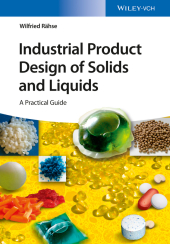 Neuerscheinungen 2014Stand: 2020-02-01 |
Schnellsuche
ISBN/Stichwort/Autor
|
Herderstraße 10
10625 Berlin
Tel.: 030 315 714 16
Fax 030 315 714 14
info@buchspektrum.de |

Wilfried Rähse
Industrial Product Design of Solids and Liquids
A Practical Guide
1. Auflage. 2014. 488 S. 200 SW-Abb. 244 mm
Verlag/Jahr: WILEY-VCH 2014
ISBN: 3-527-33335-5 (3527333355)
Neue ISBN: 978-3-527-33335-6 (9783527333356)
Preis und Lieferzeit: Bitte klicken
Offering invaluable insights from a chemist with over 35 years experience in the industry, this practical guide incorporates numerous practical examples and case studies to explain the concepts included here. The author explains the processes involved in product design, how to set up experiments, and ultimately how to scale-up. Among the host of topics covered is a discussion of recent advances in the fundamentals and innovative technologies leading to new and improved products.Essential reading for the pharmaceutical, cosmetics and personal care, food, fragrance, paints, plastics and agricultural industries.
Preface
CHEMICAL PRODUCT DESIGN - A NEW APPROACH IN PRODUCT AND PROCESS DEVELOPMENT
Definitions
Customer Involvement
Specifications
Tasks of Development Team
Steering of Projects
Learnings
DIVERSITY OF PRODUCT DESIGN
General Remarks
Customizable Developments
Foodstuffs
Chemicals
Cosmetics and Pharmaceuticals
Polymers and Plastics
Ceramic Industry
Packaging
Brand
Learnings
GENERATION AND ASSESSMENT OF IDEAS FOR NOVEL PRODUCTS
Innovation
Implementation of a Product Idea
Project Success (Some Personal Reflections on the People Involved)
Generation of Innovations
Evaluation of Product Ideas
Learnings
COMPRESSED DEVELOPMENT AND IMPLEMENTATION OF INNOVATIONS
Preliminary Remarks
Reasons for an Accelerated Product Development
Risks
Barriers in Development Projects
History
Compressed Project Processing
Project Leadership
Teamwork in Projects
Conditions for Success of Compressed Project Work
Design of Production Plant
Biotechnology
Maximum Speed-to-Market (Examples)
Relationship between Compressed Development and Product Design
Outlook
Learnings
PRODUCT DESIGN OF PARTICLES
Dry Agglomeration Processes: Pelleting and Tableting
Wet Agglomeration Processes: Granulation
Learnings
PRODUCT DESIGN OF PARTICLES BY COATINGS
Processes for Setting the Product Design of Particles
Opportunities for Influencing the Particle Design
Tasks of Coatings
Basic Variants of Coating
Coating Technologies
Learnings
PRODUCT DESIGN OUT OF DISPERSE AND CONTINUOUS PHASES BY CRUSHING
Breaking Up of Materials
Importance of Crushing Processes
Particle Properties by Breaking Up
Variants of Crushing
Processes for Crushing of Materials
Energy Requirements
Determination of Product Design via Specifications
Design of Products by Breaking Up Processes
Product Design Out of Multistep Processes (Examples)
Consequences
Learnings
PRODUCT DESIGN OUT OF CONTINUOUS PHASES BY SPRAY DRYING AND CRYSTALLIZATION
Importance of Spray Drying
Basics of Atomization and Drying
Spray Drying Plants and Plant SafetyImproved Capacity and Energy Consumption
Influencing the Product Design
Scale-Up of Spray Dryers
Exhausted Air and Waste Water
Spray Agglomeration
Crystallization / Precipitation
Learnings
MANUFACTURING OF APPLICATION-RELATED DESIGNED PLASTIC PRODUCTS
Polymers
Importance of Plastics
Task
Polymer Design for Plastics
Polymers in Detergent Formulations
Plastics in Detergent Industry
Shape and Function
Learnings
PRODUCTION OF TAILOR-MADE ENZYMES FOR DETERGENTS
Product Design in Biotechnology
History
Enzymes
Enzymes in Detergents
Industrial Manufacture of Proteases
Workplace Safety
Product Design of Enzymes
Learnings
DESIGN OF SOLID LAUNDRY DETERGENTS ACCORDING TO CONSUMER REQUIREMENTS
Market Products in Germany
Identification and Consideration of Customer Needs
History of Laundry Washing
Washing Process
Recipe
Design of Finished ProductsManufacturing Processes
Novel Manufacturing Method for Granules
Economic Considerations
Outlook
Learnings
PRODUCT DESIGN OF LIQUIDS
Introduction
Water-Based Liquids
Water-Insoluble Liquids (Example: Perfume Oils)
Learnings
DESIGN OF SKIN CARE PRODUCTS
History of Cosmetics
Regulations of Cosmetics Products
Product Design
Skin Care
Emulsions
Structure of Skin Creams
Essential Active Substances from Medical Point of View
Penetration into the Skin
Targeted Product Design in the Course of Development
Production of Skin Care Products
Bottles and Prices for Cosmetic Creams
Design of all Elements
Learnings
INFLUENCING THE PRODUCT DESIGN BY CHEMICAL REACTIONS AND MANUFACTURING PROCESS
General Remarks
Elements of the Manufacturing Process
Raw Materials and Synthesis Routes
Chemical Reactor and Reaction Sequence
Entire Procedure
Choice of Machines and Apparatuses
Operation Conditions
Drying Gas
Learnings
DESIGN OF DISPERSE SOLIDS BY CHEMICAL REACTIONS
Importance of Solid-State Reactions
Theoretical Base


